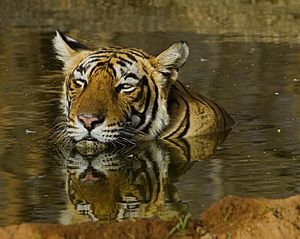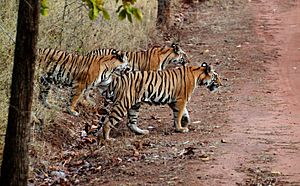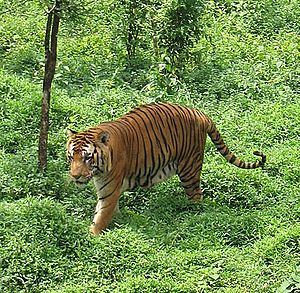Bengal tiger facts for kids
Quick facts for kids Bengal tigerBengali: বাঘ Hindi: बाघ |
|
|---|---|
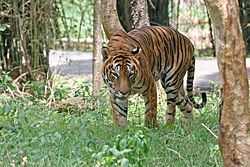 |
|
| Bengal tiger in Bannerghatta National Park | |
| Conservation status | |
| Scientific classification | |
| Kingdom: | |
| Phylum: | |
| Class: | |
| Order: | |
| Family: | |
| Subfamily: | |
| Genus: | |
| Species: | |
| Trinomial name | |
| Panthera tigris tigris |
|
The Bengal tiger (Panthera tigris tigris) is a type of tiger. It is found in countries like Bhutan, Nepal, Bangladesh, and northern India. This amazing animal is the national animal of both India and Bangladesh.
Bengal tigers live in many different places. These include wet evergreen forests, dry forests, and mangrove swamps. They also live in grasslands and forests on hills.
Contents
What They Look Like
Bengal tigers have beautiful coats that are yellow to light orange. They have dark brown to black stripes. Their belly and the inside of their legs are white. Their tail is orange with black rings.
Sometimes, you might see a white tiger. These are a special kind of Bengal tiger. They are not albino, but have a different gene that makes their fur white. White tigers have been seen in places like Assam and Bengal.
Male Bengal tigers are quite large. They can be about 2.7 to 3.1 meters (about 9 to 10 feet) long, including their tail. Females are a bit smaller, usually 2.4 to 2.65 meters (about 8 to 8.7 feet) long. Their tails are long, about 85 to 110 centimeters (about 33 to 43 inches).
At their shoulders, tigers are usually 90 to 110 centimeters (about 35 to 43 inches) tall. Males can weigh from 180 to 258 kilograms (about 400 to 570 pounds). Females are lighter, weighing 100 to 160 kilograms (about 220 to 350 pounds). The smallest Bengal tigers are found in the Sundarbans in Bangladesh.
Bengal tigers have very strong teeth. Their canine teeth are the longest of all living cat species. They can be 7.5 to 10 centimeters (about 3 to 4 inches) long!
Where They Live
Bengal tigers live in many different types of forests and grasslands. These include wet evergreen forests, dry forests, and forests where trees lose their leaves. They also live in mangrove swamps and grasslands near rivers.
The tigers in the Sundarbans in India and Bangladesh are special. They are the only tigers in the world that live in mangrove forests. There are about 70 tigers in the Indian Sundarbans.
Life and Habits
Bengal tigers usually live alone. They hunt by themselves for animals that are spread out in the forest or tall grass. Each tiger has its own home area. Adult tigers stay in a certain area where they can find food, water, and a safe place to rest.
Female tigers also need enough space for their cubs to grow. Tigers in the same area know where each other are. This helps them find other tigers, especially for mating.
Hunting and Food
Tigers are carnivores, meaning they eat meat. They like to hunt large animals such as chital deer, sambar deer, and gaur (a type of wild cattle). They also hunt wild boar and sometimes smaller animals like porcupines or hares.
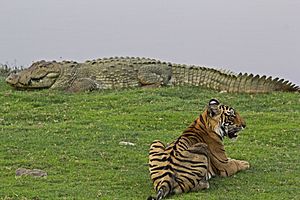
Tigers usually sneak up on their prey from the side or behind. They grab the animal's throat to kill it. Then, they drag the animal's body to a hidden spot to eat it. They can drag heavy prey for hundreds of meters! Tigers often eat a lot of meat at once, sometimes 18 to 40 kilograms (about 40 to 90 pounds). This is because they might not eat again for a few days.
Bengal tigers have also been known to hunt other predators. These can include leopards, wolves, and even crocodiles. However, these animals are not their usual food.
Growing Up
After about 104 to 106 days, a mother tiger gives birth to 1 to 4 cubs. The cubs are born in a safe place like tall grass, thick bushes, or caves.
Newborn cubs weigh about 780 to 1600 grams (about 1.7 to 3.5 pounds). They have soft, thick fur. Their eyes and ears are closed at birth. Their first teeth appear after about 2 to 3 weeks. They drink their mother's milk for 3 to 6 months.
When they are about 2 months old, cubs start to eat a little solid food. They also begin to follow their mother when she hunts. By 5 to 6 months old, they start to learn how to hunt themselves.
When they are 2 to 3 years old, young tigers start to leave their family. They look for their own area to live in. Young male tigers usually go further away from their mother's territory than young females. Once the cubs have left, the mother tiger can have more babies.
Dangers to Tigers
Over the last 100 years, the number of tigers has gone down a lot. There are not enough large areas for tigers to live safely. Losing their homes and poaching are big threats to tigers.
Why They Are Poached
The biggest danger to wild tigers is the illegal trade of their skins and body parts. This trade happens between India, Nepal, and China.
Many tigers are killed illegally. For example, between 1994 and 2009, over 893 tigers were reported killed in India. This is just a small part of how many tigers were actually poached. In 2006, the Sariska Tiger Reserve in India lost all 26 of its tigers, mostly because of poaching.
Cool Facts About Bengal Tigers
- India has the most Bengal tigers in the world.
- There are only about 3,000 Bengal tigers left in the wild.
- Bengal tigers can swim very fast, up to 60 kilometers per hour (about 37 mph).
- They are super strong! They can drag prey that is heavier than themselves for half a mile.
- Crocodiles and snakes are some animals that can kill tigers.
- Tigers can't purr like house cats, but they make a sound called a "chuff."
- Bengal tigers usually live for about 18 to 25 years.
- They can even eat venomous snakes!
Images for kids
-
Tigers in Bandipur National Park
-
A tiger attacking a Sambar deer in Ranthambore Tiger Reserve
-
Tigers at Indira Gandhi Zoological Park, Visakhapatnam, Andhra Pradesh
See also
 In Spanish: Tigre de Bengala para niños
In Spanish: Tigre de Bengala para niños



